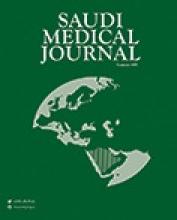Abstract
OBJECTIVE: This study highlights the spectrum of general surgical problems necessitating admission on intellectually disabled adult patients. Problems encountered in the management and the ways to overcome various difficulties are highlighted.
METHODS: Prospective collection of data on 63 consecutive developmentally disabled adult patients admitted to the Department of General Surgery, Riyadh Medical Complex (RMC), Riyadh, Kingdom of Saudi Arabia for various indications from January 2000 through December 2004. Demographic details, clinical presentation, diagnostic modalities, associated physical and neurological disabilities, coexisting medical condition, treatment options, morbidity and mortality were analyzed. Various difficulties encountered during the management and mean to overcome these problems are addressed.
RESULTS: Sixty-three patients accounted for 71 admissions. Mean age was 26.7 years with a male preponderance (4.25:1). Fifty-four patients were admitted for various emergency conditions. History of pica could be obtained in 33% of the cases. Twenty-seven patients were admitted for acute abdomen. Volvulus of the colon (22.2%) and pseudo-obstruction (18.5%) were the most common causes of acute abdomen. Twenty-one patients were admitted with upper gastrointestinal bleeding. Reflux esophagitis was the most common cause of bleeding (62%). Overall morbidity was 41% for emergency admissions and 22% for elective surgery. Hospital mortality was 21.4% for emergency surgery. There was no death in elective cases.
CONCLUSION: Developmentally disabled patients comprise a special class of patients with peculiar management problems. The treating clinician should be aware of various unexpected conditions not found as frequently in the normal patient population. Apparent lack of pain does not exclude an acute emergency. Possible surgical condition should be suspected if there is vomiting, abdominal distension, fever, increased irritability of recent onset. Male gender and history of pica are added risk factors.
- Copyright: © Saudi Medical Journal
This is an open-access article distributed under the terms of the Creative Commons Attribution-Noncommercial-Share Alike 3.0 Unported, which permits unrestricted use, distribution, and reproduction in any medium, provided the original work is properly cited.






